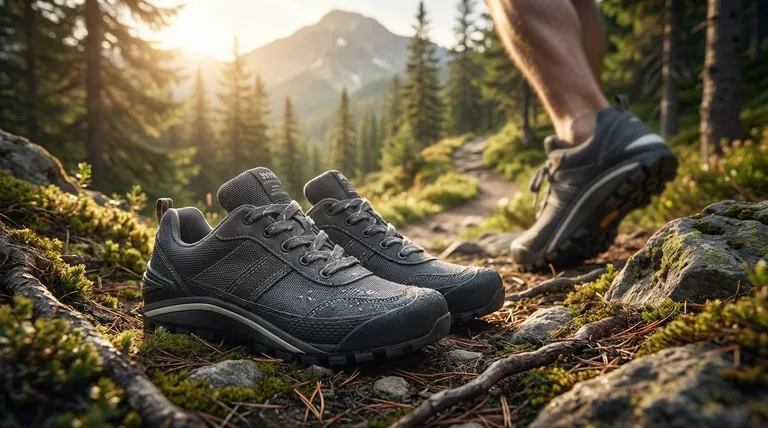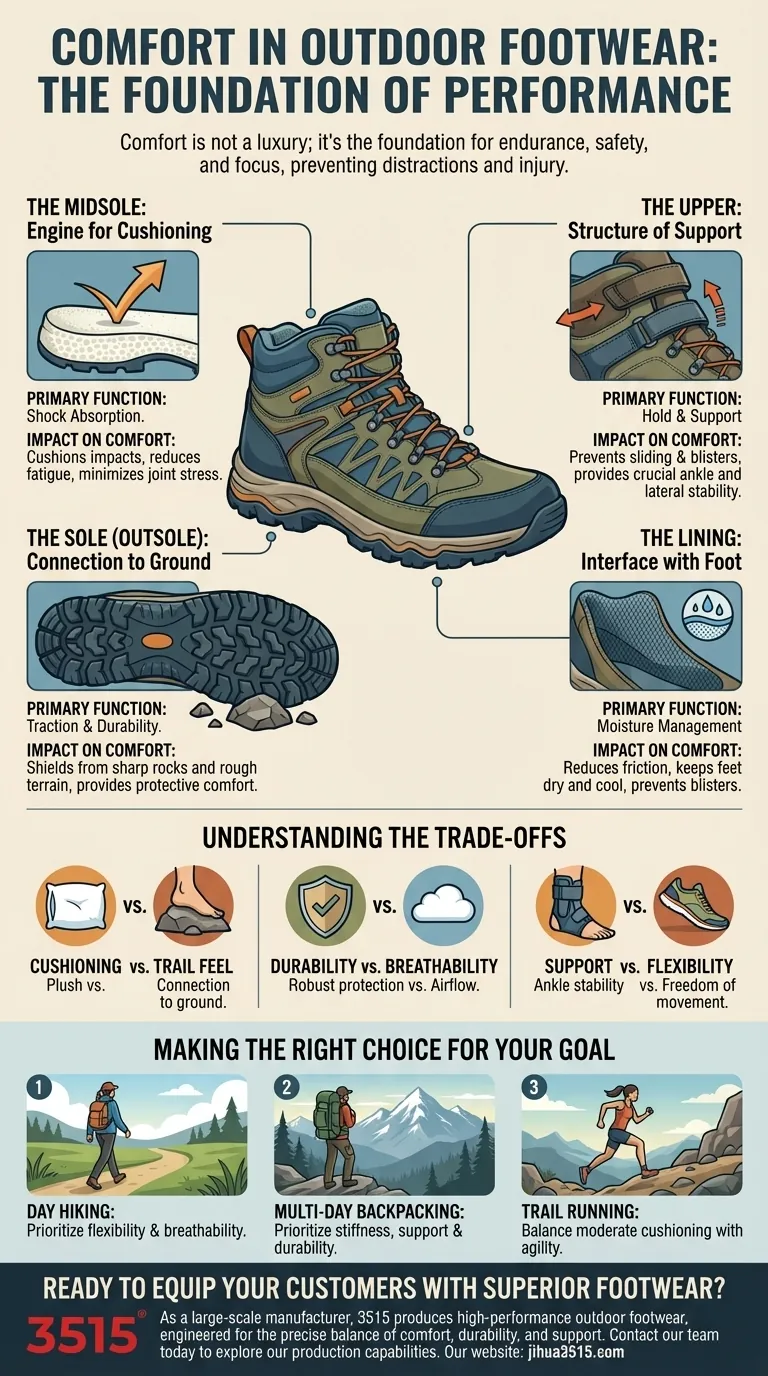In outdoor footwear, comfort is not a luxury; it is the foundation of performance, endurance, and safety. An uncomfortable shoe doesn't just ruin an experience; it actively works against you, creating painful distractions like blisters and hot spots, causing premature fatigue, and increasing the risk of missteps and injury. The right comfort allows you to focus entirely on the trail ahead.
True outdoor footwear comfort isn't about initial softness, but about a precise mechanical system. It's achieved when the shoe's core components work in synergy to support your foot's unique shape and your natural walking style, effectively preventing fatigue and pain over demanding terrain.

The Four Pillars of Footwear Comfort
While an outdoor shoe has many parts, its comfort and stability are dictated by four critical elements. Understanding their individual roles is key to selecting the right footwear.
The Midsole: Your Engine for Cushioning
The midsole is the layer between your foot and the rugged outsole. Its primary job is shock absorption.
Every step you take sends impact forces up through your joints. A well-designed midsole, typically made of EVA or polyurethane foam, cushions these impacts, reducing stress on your feet, ankles, and knees. This is the component most responsible for how "cushioned" a shoe feels underfoot.
The Upper: The Structure of Support
The upper is everything that covers the top and sides of your foot. Its purpose is to hold your foot securely and provide structural integrity.
A good upper prevents your foot from sliding around inside the shoe, which is a primary cause of blisters. It also provides crucial ankle and lateral support, protecting you on uneven ground.
The Sole (Outsole): Your Connection to the Ground
The outsole is the rubber layer that makes direct contact with the trail. While primarily for traction and durability, it plays a vital role in comfort.
A robust sole protects your foot from sharp rocks, roots, and rough terrain. This protective function is a form of comfort, preventing the acute pain that can quickly end a hike.
The Lining: The Interface with Your Foot
The lining is the material on the inside of the shoe that touches your sock. Its main job is moisture management and friction reduction.
A smooth, breathable, and moisture-wicking lining helps keep your feet dry and cool. This is critical for preventing blisters, which are caused by a combination of moisture and friction.
Understanding the Trade-offs
Perfect comfort in one area often requires a compromise in another. Recognizing these trade-offs is the mark of an informed decision.
Cushioning vs. Trail Feel
Highly cushioned shoes feel plush and are excellent for absorbing impact on hard-packed trails. However, that thick cushioning can also numb your connection to the ground, reducing your stability and proprioception on technical terrain.
Durability vs. Breathability
Robust, waterproof uppers made of leather or thick synthetics offer maximum protection and durability. The trade-off is often poor breathability, which can lead to hot, sweaty feet. Lighter, mesh-based uppers offer superior airflow but are more susceptible to wear and tear.
Support vs. Flexibility
Stiff, high-cut boots provide exceptional ankle support, which is critical when carrying a heavy pack or navigating scree fields. On simple, well-maintained trails, however, this same stiffness can feel restrictive and unnecessarily heavy.
Making the Right Choice for Your Goal
Ultimately, the "most comfortable" footwear is the one best matched to your intended activity.
- If your primary focus is day hiking on maintained trails: Prioritize a flexible shoe with good midsole cushioning and a highly breathable upper.
- If your primary focus is multi-day backpacking with a heavy pack: You need a stiffer boot with a robust upper for ankle support and a durable sole for protection.
- If your primary focus is fast-and-light trail running: Look for a lightweight shoe with a balance of moderate cushioning and excellent ground-feel for agility.
Choosing the right footwear is about selecting the precise tool that allows you to forget your feet and focus on the journey.
Summary Table:
| Component | Primary Function | Impact on Comfort |
|---|---|---|
| Midsole | Shock Absorption | Cushions impact on joints, reduces fatigue |
| Upper | Structure & Support | Holds foot securely, prevents blisters |
| Outsole | Traction & Protection | Shields from rough terrain, provides stability |
| Lining | Moisture Management | Reduces friction, keeps feet dry and cool |
Ready to Equip Your Customers with Superior Footwear?
As a large-scale manufacturer, 3515 produces a comprehensive range of high-performance outdoor footwear for distributors, brand owners, and bulk clients. Our expertise ensures every pair is engineered with the precise balance of comfort, durability, and support your customers need.
We help you deliver:
- Optimal Performance: Shoes built on the four pillars of comfort for endurance and safety.
- Informed Selection: The right footwear for every activity, from day hiking to heavy backpacking.
- Reliable Quality: Durable construction that builds trust in your brand.
Let's discuss how we can support your product line. Contact our team today to explore our production capabilities.
Visual Guide

Related Products
- Durable Rubber Sole Outdoor Shoes Wholesale & Custom Manufacturing
- Durable Waterproof Rain Boots | Custom Manufacturer for Wholesale & Brands
- Safety Footwear Wholesale Manufacturer for Custom OEM/ODM Production
- Durable Rubber-Soled Utility Shoes for Wholesale & Custom Brand Manufacturing
- Premium Sport Style Safety Boots for Bulk Orders
People Also Ask
- How does cushioning work in hiking shoes? The Science of Shock Absorption
- What are the disadvantages of vulcanized soles? Lack of Support & Durability Explained
- Why are rubber-soled shoes considered multi-weather footwear? Unlock All-Season Traction & Protection
- What were traditional shoe soles made from before rubber? The History of Leather Soles
- What are the main applications of vulcanized rubber? Unlock Durability for Tires, Footwear & More



















